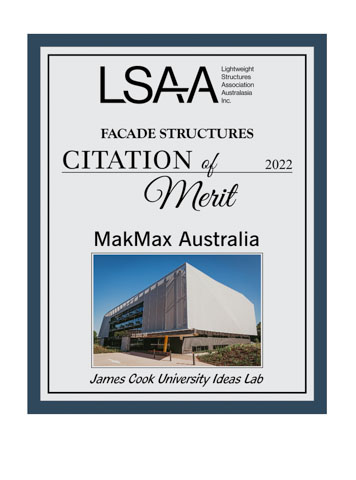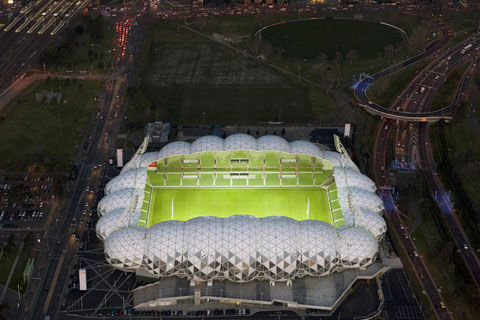
APPLICATION OF PROJECT:
The JCU Ideas Lab Facade is a PTFE mesh membrane façade which envelopes the building on all 4 sides.
PROJECT DESCRIPTION:
In a space designed “to encourage collisions of ideas”, the JCU Ideas Lab façade is a great example of modern building design incorporating an architectural membrane façade. Using a PTFE mesh fabric envelope, the James Cook University Ideas Lab façade plays with the idea a simple prosaic building can be transformed in something that is unique and beautiful.
The folded building form gives the JCU Ideas Lab façade a presence in the landscape, while at the same time moderating heat and glare and maximising natural light to the workplaces within. At night, the building is transformed by projecting moving images and colour onto the PTFE façade allowing the Ideas Lab to become a focal point for the University.
DESIGN / FABRICATION / INSTALLATION BRIEF
Wilson Architects approached us to create a “fabric screen” as part of their design for the new Ideas Lab at James Cook University in Cairns. The mesh façade was to provide sun protection for the building, while still allowing plentiful natural light into the classrooms, labs and workspace.
The overall construction of the building was by BESIX Watpac, and we were responsible for the design, engineering, fabrication and installation of PTFE membrane façade, including the external steel façade support framework. The geometric design of the building with its undulating faceted façade creates unique forms and interesting planes and was an exciting project to be involved with.
STRUCTURAL SYSTEMS
The multi-faceted façade wraps around all four-sides of the building. These faceted edges were achieved using a secondary steelwork frame around the whole building, offset from the walls by varying distances from 900mm to 2000mm. The PTFE mesh fabric was affixed to the perimeter of the façade frame with aluminum extrusions and held in place with vertical clamp plates running down the mid-frame vertices.
The front side of the building has an open ’green wall’ where the façade membrane gives way to a vertical garden. Over time, the plants will grow and cascade in front of the windows – and so the overall structural framework of the façade was engineered to tolerate the gradual growing weight of the plants.
Key to the project was a close collaboration with the building engineer to provide the steel support that comes off the building for the façade to wrap around. We also had to co-ordinate with the signage manufacturer to ensure the reaction loads for our steelwork for the façade and also the placement of fixing locations for the JCU signs we in place and incorporated into our design and installation sequence.
We included unobtrusive bird-deterrent spikes on the horizontal steelwork on the inside of the membrane shell. Designed to keep the birds from nesting in the interior structural steelwork, which will result in less maintenance on the building-side of the façade, while also keeping the glass building surface clean from bird droppings.
MATERIALS
The strength and durability of Chukoh FGJ 412-28 PTFE mesh was chosen for the façade material. Using PTFE mesh was an advantage as the façade material, as the external façade structure needed to be designed and engineered to withstand the cyclonic winds that Tropical North Queensland is occasionally subjected to.
The use of a PTFE mesh allows students and faculty inside the buildings to have unimpeded views out through the façade, while also allowing natural light ingress to the building, helping to reduce overall power consumption. The use of open-weave also provides a significant reduction in thermal heat gain, leading to further reduction in power consumption in cooling the building throughout the day, helping to create a sustainable, energy efficient building.
The modern-look silver colour chosen for the PTFE helps to define the angled edges in the daylight, while at night, the building is transformed by projecting moving images and colour onto the PTFE façade allowing the Ideas Lab to become a focal point for the University.
FABRICATION
The PTFE panel sections were manufactured in our Brisbane factory. The faceted geometry of façade required detailed patterns in order to fabricate two-dimensional plotted fabric sections into three-dimensional shapes that could easily be craned into position in sections and then clamped onto the structure.
COLLABORATION, CONSTRUCTION AND MAINTENANCE
The shape of the structure challenged our engineers and install teams to innovate for the best outcomes. The geometry of the steel structure required specialized engineering and install methodology in order to align the seams. Coordinating the position of the steel members with the fabric position required all the experience and knowledge of our install team.
The panel sequence were determined by installation size and because the fabric panels where so large they were lifted into position by crane then secured in place. We had to complete a complex install analysis prior to arriving onsite to make sure install was done safely.
There were a number of other obstacles to overcome on this project, not the least of which was the global COVID-19 pandemic. With construction beginning in the early days of quarantines and restrictions, the mobilisation of experienced installation staff had to occur around forced quarantines. To add to that, unexpected unseasonable Cairns tropical storms created fabric installation challenges. Being in a cyclonic region during install saw several heavy downpours, which made install difficult as it created muddy grounds for the access equipment, and high winds meant that rope access had to be delayed several times until it was safe to resume.
Now installed, the PTFE mesh requires very little maintenance. We added bird deterrent spikes on the horizontal parts of the steel work behind the façade so there will be very little maintenance required on the inside. Maintenance on the outside would be done via a boom lift, which can be easily accessed as around the building it is openly landscaped.
COSTS
Confidential
COLOUR IMAGES
- 5133_01-Installation1.jpg
- 5133_02-Installation2.jpg
- 5133_03-Installation3.jpg
- 5133_04-Installation-racing-the-storms.jpg
- 5133_05-Detail-Inside1.jpg
- 5133_06-Detail-Inside2.jpg
- 5133_07-Detail-Outside.jpg
- 5133_08-Detail-Corner.jpg
- 5133_09_Detail-Side-elevation.jpg
- 5133_13-Exterior-evening.jpg – image courtesy of BESIX Watpac
- 5133_14_Exterior-HERO.jpg
OTHER INFORMATION
PROJECT CREDITS
Project ID Number 5133
Project Name JCU Ideas Lab
Project Location 1 James Cook Drive, Douglas, QLD 4811GPS Location 19.3259° S, 146.7567° E
Completion Date Jul-20
Preferred Category 5 Glazing & Vertical Facades
Entrant Name MakMax Australia
Address 133 Lavarack Ave, Eagle Farm, QLD 4009Contact Phone Number 07 3633 5900
Email Address
Website Address www.makmax.com.au
Entrant Type / Role Designer / Engineer / Fabricator / Installer
Project Client BESIX Watpac
Project Architect Wilson Architects
Structural Engineer Michael Chong - MakMax Australia
Fabricator(s) MakMax Australia
Others Subcontractor: Bespoke Wire & Rope






